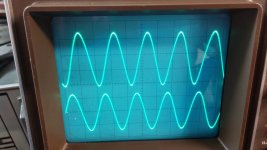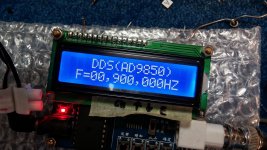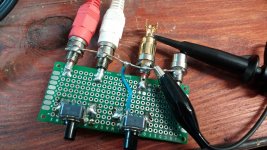If you have the input pairs thermally coupled and hfe matched one thing it's worth to try is to link out the NFB capacitor and run the amplifier fully DC coupled. Of course, the source must be DC free.
You'll hear more detail, more "finesse", and the notes decay ( specially piano) will be amazing!
You'll hear more detail, more "finesse", and the notes decay ( specially piano) will be amazing!
The NFB capacitor is the series one to ground on the inverting input of the long-tail pair.
It keeps the AC gain at about 30 (Rf/Rin) but the DC gain at 1.
With the cap shorted, the DC gain = AC gain, so any input offset from the previous amp will be multiplied by 30 and applied to your speakers ....
Do not try this at home ....... etc
Cliff
It keeps the AC gain at about 30 (Rf/Rin) but the DC gain at 1.
With the cap shorted, the DC gain = AC gain, so any input offset from the previous amp will be multiplied by 30 and applied to your speakers ....
Do not try this at home ....... etc
Cliff
Yes, that's it.🙂
The NFB capacitor does had some "blur" to the sound. It's there as a safety precaution.
The ideal would be to DC couple the amp all the way but use a DC servo to null the offset. However, the SKA is very stable if you have hfe matched input pairs and thermally couple them. With different sources (all DC free, of course), at different volume settings, the offset only varies about +-5mV. For protection is mandatory to have a speaker protection circuit fitted at the output so we play safe.
The NFB capacitor does had some "blur" to the sound. It's there as a safety precaution.
The ideal would be to DC couple the amp all the way but use a DC servo to null the offset. However, the SKA is very stable if you have hfe matched input pairs and thermally couple them. With different sources (all DC free, of course), at different volume settings, the offset only varies about +-5mV. For protection is mandatory to have a speaker protection circuit fitted at the output so we play safe.
Last edited:
Sounds dangerous. I know the SKA is a little numb sounding compared to my other amps, but I think I'll leave it alone. Sometimes that is pleasant.
Sounds dangerous. I know the SKA is a little numb sounding compared to my other amps, but I think I'll leave it alone. Sometimes that is pleasant.
It's not dangerous if you know what you're doing and use all the protections.
I know what you mean by "numb" sound and removing the NFB helps there making the highs more proiminent and detailed.
"I know what you mean by "numb" sound and removing the NFB helps there making the highs more proiminent and detailed."
I have no idea how you would explain how removing the Dc blocker cap, which has corner frequency of 3Hz or so affects the treble response in such a way?
Maybe you just believe in the usual inexplicable capacitor woo?
And yes, I have tried in on my GB150s and cannot detect any difference under any of the circumstances I tried.
But, there you go .....
I have no idea how you would explain how removing the Dc blocker cap, which has corner frequency of 3Hz or so affects the treble response in such a way?
Maybe you just believe in the usual inexplicable capacitor woo?
And yes, I have tried in on my GB150s and cannot detect any difference under any of the circumstances I tried.
But, there you go .....
"I know what you mean by "numb" sound and removing the NFB helps there making the highs more proiminent and detailed."
I have no idea how you would explain how removing the Dc blocker cap, which has corner frequency of 3Hz or so affects the treble response in such a way?
Maybe you just believe in the usual inexplicable capacitor woo?
And yes, I have tried in on my GB150s and cannot detect any difference under any of the circumstances I tried.
But, there you go .....
I don't explain. It's a fact. The NFB destrois the treble. AB blind test confirms it. Why? I don't know.
I don't have a spectrum analyser but if you have acess to one maybe you could meassure both outputs and see if you can objectivate and explain my empirical finding.
I don't explain. It's a fact. The NFB destrois the treble. AB blind test confirms it. Why? I don't know.
I don't have a spectrum analyser but if you have acess to one maybe you could meassure both outputs and see if you can objectivate and explain my empirical finding.
Allowing for English not being your mother tongue (but which seems excellent, anyway!):
Your observation is an opinion, not a fact.
NFB destroys treble! Hm.... nonsense.
BTW, you are making the claim, don't expect me to do the work in proving or disproving it for you.
Probably best to stop here. These arguments invariably end in tears before bedtime.
Cliff
Last edited:
I must appologise for this affirmation. NFB is a very good tool and it does not destroy treble or bass of mids if well implemented. I was refering to the NFB electrolytic in the SKA. I've built other amps where I honestly couldn't perceive any difference. However,in the SKA I do perceive a significant difference when I link out this electrolytic. And I much prefer the treble without it. I appologise by my earlier poor choice of words.NFB destroys treble! Hm.... nonsense.
Tha k you for your compliment about my english! 🙂 I try my best but sometimes I miss spell words...
Muito bom, Paulo!
I hope that is correct - all my Portuguese was from Brazilians in France. Like learning English English from Louisiana Americans!
Anyway, I think the point is, for me, that if you have noticed some change due to a component swap or bypass such as this, it doesn't help our newcomers, of which there are very many, to promote such changes as fact without all the caveats involved.
For example, you claim a difference in an AB test. Fine. But the details are necessary. was it really blind? etc.
Otherwise this is just chat in the bar, not useful progress in science.
Cliff
I hope that is correct - all my Portuguese was from Brazilians in France. Like learning English English from Louisiana Americans!
Anyway, I think the point is, for me, that if you have noticed some change due to a component swap or bypass such as this, it doesn't help our newcomers, of which there are very many, to promote such changes as fact without all the caveats involved.
For example, you claim a difference in an AB test. Fine. But the details are necessary. was it really blind? etc.
Otherwise this is just chat in the bar, not useful progress in science.
Cliff
I don't explain. It's a fact. The NFB destrois the treble. AB blind test confirms it. Why? I don't know.
And you are not alone against capacitors in signal path. 😉
http://www.ti.com/lit/an/snaa031a/snaa031a.pdf
"In listening tests at TI's sound room evaluating different circuit components used in the LM4702 demo amplifier, there was one part whose negative effect on audible signal quality was undeniable. A DC blocking capacitor on the input of the LM4702 degraded sound quality. In multiple listening tests, with different participants and at various locations around the country, the negative effects of even the best film and foil polystyrene DC blocking input capacitors in the audio signal path was confirmed. It is therefore recommended that DC blocking capacitors not be used in the signal path for mid to high-end audio equipment. Where DC offset from another signal source may be a problem then the use of a DC servo circuit that keeps DC offset from appearing at the output of the amplifier is recommended."
That is an interesting comment, which poses the immediate question of "how did they do it"?
The same amplifier, switch off, unsolder cap, replace with link and then add servo, switch on again, check levels then ask for comparisons?
Or two different boards, one with a cap, one without but with a servo. Swapped how? Cable swap, switch box?
I have little expertise in rigorous test methods. Others do, and it is well researched and documented.
This TI comment should not be forgotten, but is as useful as "They preferred the blue one to the pink one" without full information.
9 out of 10 housewives who expressed a preference, preferred DAZ.
The same amplifier, switch off, unsolder cap, replace with link and then add servo, switch on again, check levels then ask for comparisons?
Or two different boards, one with a cap, one without but with a servo. Swapped how? Cable swap, switch box?
I have little expertise in rigorous test methods. Others do, and it is well researched and documented.
This TI comment should not be forgotten, but is as useful as "They preferred the blue one to the pink one" without full information.
9 out of 10 housewives who expressed a preference, preferred DAZ.
Muito obrigado! 🙂Muito bom, Paulo!
I don't usually do blind tests for every mod I make. This time the difference was big to my ears and I wanted to make sure I wasn't imagining things.
It probably wasn't a fully correct scientific test but the objective was just for me to know if the difference was real. I enlisted the help of 3 friends. One of them got "switch duty" and me and the other 2 friends got "ear duty".
We installed a rellay to short circuit the NFB capacitor. We listened to 10 seconds of music and then my friend with the switch signaled with his hand (and no sound) and the music kept playing for more 10 seconds. Of course, he was instructed to lie sometimes and we would't know if he really had flip the switch.
In a piece of paper the tree of us wrote if we though the first 10 s of music were the same way of the last 10 ( that is,if we though the switch had been fippled). We did that 10 times.
I got 9 of 10 right and my two other friends had 7 and 8 times. None of us have golden ears. And the amp survived even with a relay going back and forward!
That is, however, one thing we didn't think of: when the offset is nulled with the capacitor in place and we link it out, the offset jumps a few 10s of mV. But I'm assuming this doesn't have an audible effect.
I must stress that the amplifier sounds wonderfull both ways. No need to run and link out the NFB capacitor. I just perceive (and prefer) more detail and better highs ( better to my ears) without this capacitor.
Last edited:
"They preferred the blue one to the pink one" without full information.
Well, I must agree as many high end commercial equipment use caps, and it still sounds wonderful. Especially tubes. But it may be I prefer "pink one". 😀
Hi Guys,
I just came in from the shop. I have two boards sitting side by side on the same heatsink, One set up exactly as Jim's audio schematic is drawn and the other with just C10 & C11 and with 100K in R11 & 13. I hooked both up to the scope and ran square and sine waves from 1k to 100K. No difference. I checked again about disconnecting the extra ground wire and I get instant oscillation with both channels connected. So to test my theory I soldered jumpers at R14 and the oscillation is gone even without the extra ground wire. Sorry, but I'm not going to chance bypassing the NFB cap. I could probably do it in the amp that is in the case because it has a speaker protection circuit but I think I will leave well enough alone. It sounds fine like it is. Maybe if it were my only amp I would look into it, not sure.
I just came in from the shop. I have two boards sitting side by side on the same heatsink, One set up exactly as Jim's audio schematic is drawn and the other with just C10 & C11 and with 100K in R11 & 13. I hooked both up to the scope and ran square and sine waves from 1k to 100K. No difference. I checked again about disconnecting the extra ground wire and I get instant oscillation with both channels connected. So to test my theory I soldered jumpers at R14 and the oscillation is gone even without the extra ground wire. Sorry, but I'm not going to chance bypassing the NFB cap. I could probably do it in the amp that is in the case because it has a speaker protection circuit but I think I will leave well enough alone. It sounds fine like it is. Maybe if it were my only amp I would look into it, not sure.
This from Ti, tells me that Ti know next to nothing about the National designed chip.the negative effects of even the best film and foil polystyrene DC blocking input capacitors
Why?
Because the DC blocking cap on the input should be set at a size to pass the audio signal.
What size of polystyrene cap did they tell us they used?
It was obviously so important to their test that they considered that the readers did not need to know !
Forget the Ti statement. At best it is misleading, more likely it is just wrong !
So guys, the problem has been solved. Problem was my great volume regulator. Sine 900kHz is still fine, square is on 20kHz also perfect ....
Volume reg problem - YouTube
Volume reg problem - YouTube
Attachments
- Home
- Amplifiers
- Solid State
- SKA GB150D now public domain...



